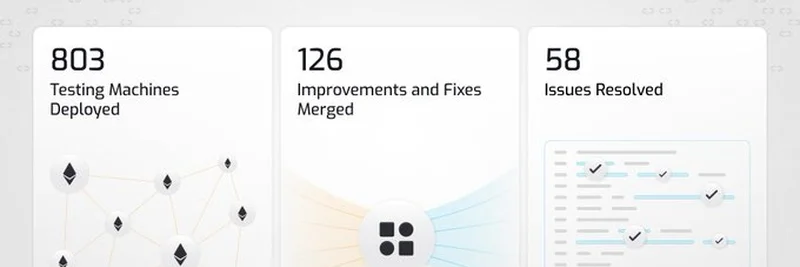If you’re into the world of blockchain and Ethereum, you’ve probably heard of Nethermind, a key player in the Ethereum ecosystem. Recently, they dropped an exciting update with their July 2025 Client Report, and it’s packed with goodies for anyone interested in how Ethereum keeps evolving. Let’s break it down in a way that’s easy to digest, even if you’re new to the tech!
What’s in the July 2025 Report?
The Nethermind team has been busy, and the numbers speak for themselves:
- 803 Testing Machines Deployed: That’s a huge network of machines working to test and refine the client, ensuring it runs smoothly across the Ethereum network.
- 126 Improvements and Fixes Merged: These are updates and bug fixes that make the client faster and more reliable.
- 58 Issues Resolved: Problems that could’ve slowed things down? They’re history now!
This report isn’t just about stats—it’s a peek into the hard work happening behind the scenes to keep Ethereum strong and decentralized.
What Did They Work On?
The team tackled a variety of areas to level up the Nethermind client. Here’s a rundown:
- Protocol Readiness: They’ve implemented new Ethereum Improvement Proposals (EIPs) and upgrades to stay on track with Ethereum’s future plans. Think of EIPs as blueprints for making Ethereum better!
- Node Reliability: They fixed edge cases—those tricky, rare scenarios—that could cause data loss, making nodes (the computers running Ethereum) more stable.
- Performance Optimization: By reducing CPU load and hardware needs while boosting throughput (how much data moves through), they’ve made the client more efficient.
- ZK Compatibility: Zero-knowledge (ZK) tech is a hot topic in blockchain for privacy and scalability. Nethermind expanded support for this, aligning with emerging standards.
- Smarter Sync Defaults: Syncing a node (getting it up to speed with the network) is now easier with less manual tweaking required.
- Operational Visibility: Better monitoring tools help operators keep an eye on node health, catching issues before they escalate.
- P2P Network Stack: Improved peer-to-peer connections mean smoother communication between nodes.
- Developer Support: They’ve simplified testing and debugging for Layer 2 (L2) simulations, which are like turbochargers for Ethereum’s scalability.
- Long-Term Maintainability: With a focus on modular design and testing, the client is built to grow and improve over time.
Why This Matters for Ethereum
Ethereum thrives on diversity—having multiple clients like Nethermind ensures the network isn’t reliant on just one system. This reduces risks of outages or attacks and keeps decentralization alive. The Nethermind client’s efforts in performance and reliability are a big step toward a more robust Ethereum ecosystem.
A Quick Note on Meme Tokens
While this report focuses on technical upgrades, it’s worth mentioning that a strong Ethereum foundation also supports the wild world of meme tokens. As Ethereum gets faster and more reliable, it creates a better playground for these fun, community-driven cryptocurrencies. Who knows? The next big meme coin might ride on these improvements!
Final Thoughts
The July 2025 Nethermind Client Report shows a team committed to pushing Ethereum forward. With 803 testing machines, 126 merged updates, and 58 resolved issues, they’re laying the groundwork for a more efficient and secure network. Whether you’re a developer, a node operator, or just a blockchain enthusiast, these updates are worth watching. Stay tuned to meme-insider.com for more insights into how these changes might ripple through the crypto world!
Got questions about Nethermind or Ethereum upgrades? Drop them in the comments—we’d love to chat!


